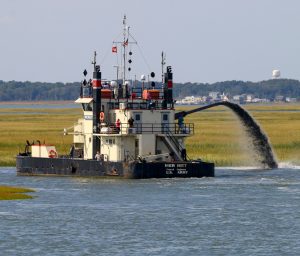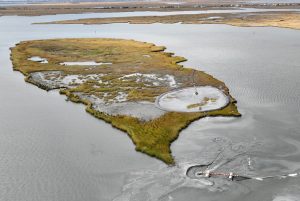by Steve Rochette, Public Affairs Officer, U.S. Army Corps of Engineers and
Dr. Lenore Tedesco, Executive Director, The Wetlands Institute
 No one organization can solve the most complex or difficult societal and environmental issues. Moving beyond the status quo and taking bold action is not always neat and linear. Thus, it’s no surprise that the work to beneficially use clean, dredged sediment to enhance drowning marshes has only been possible through extensive partnership and collaboration. More than five years ago, the Seven Mile Island Innovation Lab (SMIIL) founders – the U.S. Army Corps of Engineers, the State of New Jersey, and The Wetlands Institute – came together to change this and make progress to restore and enhance drowning marshes, while managing navigation in the New Jersey Intracoastal Waterway. It could clearly be a win-win situation with benefits across the board, if we could pull it off.
No one organization can solve the most complex or difficult societal and environmental issues. Moving beyond the status quo and taking bold action is not always neat and linear. Thus, it’s no surprise that the work to beneficially use clean, dredged sediment to enhance drowning marshes has only been possible through extensive partnership and collaboration. More than five years ago, the Seven Mile Island Innovation Lab (SMIIL) founders – the U.S. Army Corps of Engineers, the State of New Jersey, and The Wetlands Institute – came together to change this and make progress to restore and enhance drowning marshes, while managing navigation in the New Jersey Intracoastal Waterway. It could clearly be a win-win situation with benefits across the board, if we could pull it off.
SMIIL is a test bed and think tank to advance and improve dredging and marsh placement techniques in coastal New Jersey. Located within the 24 square miles of marshes and bays behind Seven Mile Island, SMIIL has become a proving ground for using sediment to provide uplift and enhanced resilience for ecosystems and coastal communities.
 Each of the founding partners had its own unique charges and missions but they were complementary to solving problems. The Army Corps had the funding and need to clear navigation channels with limited places to put sediment. They also had a renewed focus on dredging innovation and knew that sediment had significant ecological value. The State of New Jersey owns and manages thousands of acres of vulnerable marshes and has a strong interest in the co-benefits that healthy marshes provide for wildlife, public recreation, and our coastal communities.
Each of the founding partners had its own unique charges and missions but they were complementary to solving problems. The Army Corps had the funding and need to clear navigation channels with limited places to put sediment. They also had a renewed focus on dredging innovation and knew that sediment had significant ecological value. The State of New Jersey owns and manages thousands of acres of vulnerable marshes and has a strong interest in the co-benefits that healthy marshes provide for wildlife, public recreation, and our coastal communities.
The Wetlands Institute has a mission to promote understanding and stewardship of marshes and the expertise and knowledge of salt marsh systems and environmental factors to help plan, monitor, and move projects forward in ways that are most beneficial to the marshes and wildlife that depend on them.
 Through partnerships, design, construction, monitoring, and adaptive management, SMIIL efforts have leveraged maintenance dredging to complete 8 projects totaling more than 85 acres and trialed a suite of nature-based solutions including elevated nesting habitat creation (Ring Island and Great Flats), and marsh edge protection, mudflat creation, and marsh enhancement (Sturgeon, Gull and Scotch Bonnet Islands).
Through partnerships, design, construction, monitoring, and adaptive management, SMIIL efforts have leveraged maintenance dredging to complete 8 projects totaling more than 85 acres and trialed a suite of nature-based solutions including elevated nesting habitat creation (Ring Island and Great Flats), and marsh edge protection, mudflat creation, and marsh enhancement (Sturgeon, Gull and Scotch Bonnet Islands).
SMIIL partners have worked with numerous other federal, state, and local government agencies; non-profits; academia; consultants; and, of course, the dredging industry. There are more than 30 scientists working in SMIIL with the help of a 50+ member Working Group. The knowledge being gained here is being rapidly shared for implementation elsewhere.
Trusted partnerships with a focus on creating change for the betterment of our marshes and coastal communities is at the core of the work of SMIIL. New Jersey is now a national leader in beneficial use projects using sediment for marsh restoration thanks in large part to the work happening right here.

